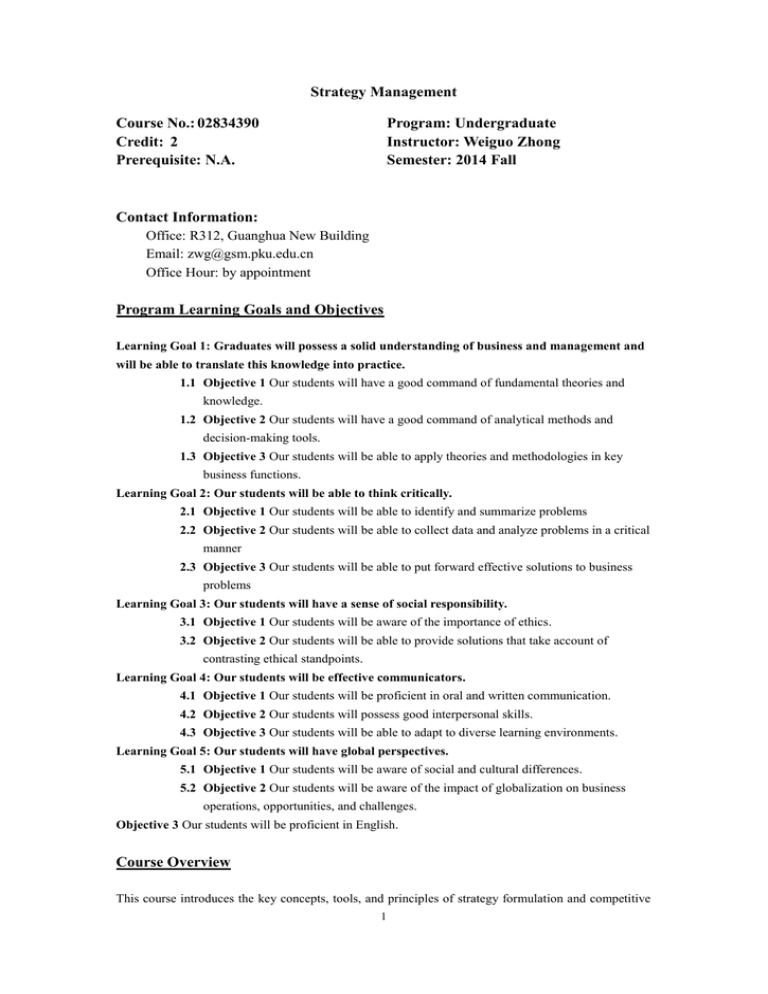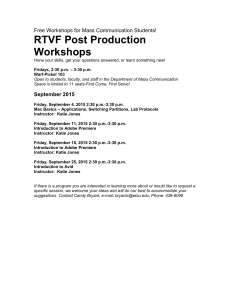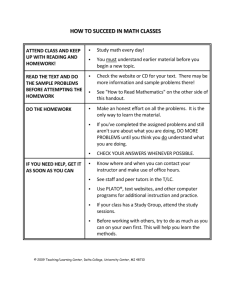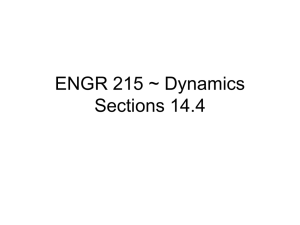Peking_2014_Strategy Management
advertisement

Strategy Management Course No.: 02834390 Credit: 2 Prerequisite: N.A. Program: Undergraduate Instructor: Weiguo Zhong Semester: 2014 Fall Contact Information: Office: R312, Guanghua New Building Email: zwg@gsm.pku.edu.cn Office Hour: by appointment Program Learning Goals and Objectives Learning Goal 1: Graduates will possess a solid understanding of business and management and will be able to translate this knowledge into practice. 1.1 Objective 1 Our students will have a good command of fundamental theories and knowledge. 1.2 Objective 2 Our students will have a good command of analytical methods and decision-making tools. 1.3 Objective 3 Our students will be able to apply theories and methodologies in key business functions. Learning Goal 2: Our students will be able to think critically. 2.1 Objective 1 Our students will be able to identify and summarize problems 2.2 Objective 2 Our students will be able to collect data and analyze problems in a critical manner 2.3 Objective 3 Our students will be able to put forward effective solutions to business problems Learning Goal 3: Our students will have a sense of social responsibility. 3.1 Objective 1 Our students will be aware of the importance of ethics. 3.2 Objective 2 Our students will be able to provide solutions that take account of contrasting ethical standpoints. Learning Goal 4: Our students will be effective communicators. 4.1 Objective 1 Our students will be proficient in oral and written communication. 4.2 Objective 2 Our students will possess good interpersonal skills. 4.3 Objective 3 Our students will be able to adapt to diverse learning environments. Learning Goal 5: Our students will have global perspectives. 5.1 Objective 1 Our students will be aware of social and cultural differences. 5.2 Objective 2 Our students will be aware of the impact of globalization on business operations, opportunities, and challenges. Objective 3 Our students will be proficient in English. Course Overview This course introduces the key concepts, tools, and principles of strategy formulation and competitive 1 analysis. It is concerned with managerial decisions and actions that affect the performance and survival of business enterprises, especially from a perspective of China firms. This course assumes a broad view of the environment that includes buyers, suppliers, competitors, technology, the economy, capital markets, government, culture, and global forces and views the external environment as dynamic and characterized by uncertainty. In studying strategy, the course takes a general management perspective, viewing the firm as a whole, and examining how policies in each functional area are integrated into an overall competitive strategy. This course is designed to prepare students to be senior managers for the increasingly competitive business world. The emphasis of this course will be on the strategic analyses, decisions, and actions that organizations take to create sustainable competitive advantages, with the consideration of both the internal condition and the external environment. Through chapters, case analyses, and discussions we will also explore issues related to ethical decision making, corporate social responsibility, stakeholder theory, and the relationship of business & government, which become increasingly important in China and global markets. The case method and oral presentation will be used extensively to combine theory and application. To effectively learn from the case method, the course will require considerable amount of preparation, analysis and class participation. Class attendance is mandatory. Course Objectives This course aims to Introduce the students with the important frameworks, concepts and techniques of strategic management. Provide students general knowledge about planning and implementing successful management strategies. Familiarize students with the marketing concepts and applications in real business situations. Detailed Course Plan Week 1 Date M 15/09 Lecture Course Introduction and Overview Lecture/Discussion: Strategic Management & Strategic Leadership (Hill & Jones Ch. 1) 2 3 M 22/09 M 29/09 External Analysis: Identify Opportunities and Threats (Hill & Jones Ch. 2) Guidelines for Conducting Case Analysis Mini case I for Individual Case Analysis Form Teams Internal Analysis and Functional-Level Strategy (Hill & Jones Ch. 3 &4) Reconfirmation of Group Compositions and Group Case Discussion Assignments 2 4 M 13/10 5 M 20/10 6 M 27/10 7 M 3/11 8 M 10/11 9 M 17/11 10 M 24/11 11 M 1/12 Mini case II for Individual Case Analysis Business-Level Strategy (Hill & Jones Ch. 5 & 6) Mini case III for Individual Case Analysis Corporate-Level Strategy (Hill & Jones Ch. 9 & 10) Mini case VI for Individual Case Analysis Detailed requirements on the final group project announcement International Strategy (Hill & Jones Ch. 8) Mini case V for Individual Case Analysis Group Case Discussion and Presentation 1: Strategy and Technology (Hill & Jones Ch. 7) Group Case Discussion and Presentation 2: Corporate Governance (Hill & Jones Ch. 11) Group Case Discussion and Presentation 3: Business Ethics and Corporate Social Responsibility (Hill & Jones Ch. 11) Group Case Discussion and Presentation 4: Strategy Implementation in Single Industries (Hill & Jones Ch. 12) Group Case Discussion and Presentation 5: Strategy Implementation in Multiple Markets (Hill & Jones Ch. 13) Group Case Discussion and Presentation 6: Teaching Methods The module is conducted in a lecture format including: Formal lectures Case analyses and class discussions Group projects and presentations IT tools to be used in the classroom Computer, projector, and videos Textbooks Main Textbook Strategic Management: An Integrated Approach, 10th Edition Charles W. L. Hill - University of Washington Gareth R. Jones - Texas A&M University ISBN-10: 111182584X ISBN-13: 9781111825843 960 Pages Casebound © 2013 Published The publisher of the text has the following website: http://www.cengage.com/aushed/instructor.do?disciplinenumber=1028&product_isbn=9781111825843 &courseid=MN03&codeid=2A46 You are encouraged to use the website to review the course material. 3 Complementary Textbook Hitt, M., Ireland, R. and Hoskisson, R. 2010. Strategic Management: Competitiveness and Globalization-Concepts, Cincinnati, OH: Southwestern College Publishing. 9th edition. Paperback. References & Readings Additional reading material will be provided as needed. Videos, CD-ROMs and other adjunct learning resources used CEO announcement videos, CEO interview video slices, and newspaper reports Rules students must follow This course requires careful readings, active discussions, diligent research, and effective group work, which will also determine whether and how a student may succeed in this course. The instructor’s main role will be to facilitate the implementations of these activities and provide constant guidance along each step of the way. Academic Integrity DO NOT COPY, PARAPHRASE OR TRANSLATE ANYTHING FROM ANYWHERE WITHOUT STATING FROM WHERE YOU OBTAINED IT! Course Assessment A student’s final grade will be based on the weighted average of the following four categories: Individual Class Participation, Individual Case Analysis, Group Case Discussion and Presentation, and Group Strategy Project, each of which will be evaluated in the form of a letter grade system (A+, A, A-, B+, B, B-, C+, C, C-, D+, D, D-, and F). a) Individual Class Participation (20%) i. In-class discussion (15%) All students are expected to attend classes and be prepared for and actively involved in the discussions during the lecture time. This part of the evaluation will be based on a student’s attendance (sign-in sheet and instructor/TA observations) and overall participation throughout the whole semester. Generally, a student can get an A level grade in this category if he/she has few or no absence, is mostly on time, and participates actively on a regular basis in class discussions. ii. Project presentation feedback (5%) Students should submit 2 presentation feedback forms (except their own presentation week) to evaluate the performance of the presenting groups in presentation weeks. Each presentation evaluation carries 2.5%. b) Individual Case Analysis (20%) 4 Each student will conduct a two to three page (double spaced) case analysis for a designated case from the instructor. The general flow of the case analysis should follow the guidelines discussed in class and address the following issues with coherent and logical writings (instead of bullet points): What are the key challenges faced by the organization? What are the main strategies used by the organization and were they successful or not? What strategic management concepts and theories can you apply? What relevant recommendations can you come up with for the future of the organization? Each student will conduct five mini-case analyses. The deadline for submission is at the beginning of the next class. Please, no late or electronic submissions. c) Group Case Discussion and Presentation (30%) 5-6 students in a group. The group leader of each group should submit their group list on or before week 3 to the instructor. Topic and presentation sequence will be assigned randomly and announced in Week 5. (1) Each group will research one of the real world companies listed in the textbook, suggested by the students, or nominated by the instructor and conduct a professional case analysis. Students are required to find additional background information from various sources including libraries, internet sites, books, magazines, and newspapers. The format is similar to that of the individual case analysis with emphases on how a group can systematically apply strategic concepts and theories and provide effective recommendations. (2) The presentation will be held from Week 7 to Week 12. One group will present their group project on each presentation week. Each group will have 20 minutes for presentation and around 5 minutes for Q&A session. English is the only medium for presentation. It is a must that the whole team attends the class on the presentation day and at least 3 members should participate in the presentation. (3) A softcopy of the presentation should be submitted by the group leader to the instructor at least 24 hours BEFORE the presentation (File name of the presentation should be in the format of: SM2014 - project topic - group number). Presentation hardcopy should be handed in to the instructor on the presentation day. 10% of total presentation scores will be deducted for any late submission. To ensure a good quality, each group is strongly urged to start the preparation process at least two weeks prior to the designated group case discussion date. d) Group Strategy Project (30%) At the end of the semester, there will be a final group project to test the students’ understanding and application of main theories and concepts learned from Week 1 to 12. Each group will be assigned a task as following: Assume your group is the top management team of a company that is going through some tough times or is struggling with some key strategic issues. You are asked to conduct an in-depth study of the firm, and apply the concepts, analytical tools and frameworks of this course to analyze its external and internal environments, identify the firm’s strategic options, and come up with a set of recommendations to maximize the firm’s long-term performance. Alternatively, you could prepare 5 a five-year strategy plan (from Jan. 2014 to Dec. 2014) and present it to the director board. A comprehensive study and analysis are strongly recommended in order to understand the strategy situation and explore the strategy opportunities of the company. Detailed requirements on the strategy planning will be announced in Week 6. Peer Evaluation It is important to notice that all group works will be subject to peer evaluation. It is important for everyone to be a TEAM PLAYER as it is one of the intended learning outcomes of the course. In case you found that you cannot get along with the team you formed on your own, the whole group should come to the instructor and discuss about the issues and remedies as soon as possible. Students should email the peer evaluation forms to the instructor on or before the last day of Week 12. Late submission will not be handled. If no submission is received for all team members, the marks will be equally allocated to group members The upper limit of evaluation is 100% while the lower limit is 50% for your final mark after the judgment from instructor. Marks and comments (without telling him/her WHO made the comments) will be released to students who got below mean of the group, before the final grade is decided. Any student who is not satisfied with the peer evaluation result can appeal. How does this course serve the Assurance of Learning Assessment? Through the assessment of class participation, individual case analysis, group case discussion, and group strategy project, and peer evaluation, we finally ensure that the students achieve the course Intended Learning Outcomes (CILOs). Upon successful completion of this course, students should be able to: No. DEC dimensions CILOs Weighting 1 Ability Analyze the customers, suppliers, competitors and other business environments with a good command of fundamental theories and analytical methods and decision-making tools 2 2 Attitude Critically identify and summarize problems, collect data and analyze problems in a critical manner, and discuss the strategic planning process and its key roles in business organizations 1 3 Ability Demonstrate competence in selecting, analyzing, evaluating, and formulating effective practice of strategy in business organizations 3 4 Attitude Develop global perspectives, be aware of social and cultural differences, and learn the impact of globalization on business operations, opportunities, and challenges 2 6 5 Ability Apply both managerial judgment and analytical approaches to current strategy problems and issues. 3 6 Attitude Have a strong sense of social responsibility, be aware of the importance of ethics, and provide solutions that take account of contrasting ethical standpoints 2 Work productively as part of a team, and in particular, communicate and present qualitative and quantitative information 7 Achievement effectively in oral, written and electronic formats in a collaborative environment (Weighting 1: Least important CILO; 2: More important CILO; 3: Most important CILO) 7 2




